Livery company
There are 110 livery companies, comprising London's ancient and modern trade associations and guilds, almost all of which are styled the 'Worshipful Company of...' their respective craft, trade or profession.[1][2] These livery companies play a significant part in the life of the City of London (i.e. the financial district and historic heart of the capital), not least by providing charitable-giving and networking opportunities. Liverymen retain voting rights for the senior civic offices, such as the Lord Mayor, Sheriffs and Corporation, its ancient municipal authority with extensive local government powers.[2]
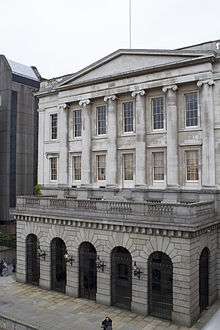
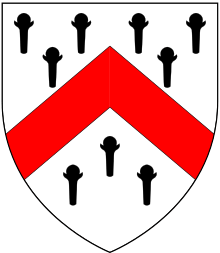
The term livery originated in the specific form of dress worn by retainers of a nobleman and then by extension to special dress to denote status of belonging to a trade. Livery companies evolved from London's medieval guilds, becoming corporations under Royal Charter responsible for training in their respective trades, as well as for the regulation of aspects such as wage control, labour conditions and industry standards. Early guilds often grew out of parish fraternal organizations, where large groups of members of the same trade lived in close proximity and gathered at the same church.[3] Like most organisations during the Middle Ages, these livery companies had close ties with the Catholic Church (before the Protestant Reformation), endowing religious establishments such as chantry chapels and churches, observing religious festivals with hosting ceremonies and well-known mystery plays. Most livery companies retain their historical religious associations, although nowadays members are free to follow any faith or none. Companies often established a guild or meeting hall, and though they faced destruction in the Great London Fire of 1666 and during the Blitz of World War II, thirty-nine companies maintain their sometimes elaborate and historic halls.[3]
Most livery companies still maintain contacts with their original trade, craft or professional roles. Some still exercise powers of regulation, inspection and enforcement, while others are awarding bodies for professional qualifications. The Scriveners' Company admits senior members of legal and associated professions, the Apothecaries' Society awards post-graduate qualifications in some medical specialties, and the Hackney Carriage Drivers' Company comprises licensed taxi drivers who have passed the "Knowledge of London" test. Several companies restrict membership to those holding relevant professional qualifications, e.g. the City of London Solicitors' Company and the Worshipful Company of Engineers. Other companies, whose trade died out long ago, such as the Longbow Makers' Company, have evolved into being primarily charitable foundations.[2]
After the Carmen received City livery status in 1848 no new companies were established for 80 years until the Master Mariners in 1926 (granted livery in 1932).[2] Post-1926 creations are known as modern livery companies. The Worshipful Company of Arts Scholars, the newest, was granted livery status on 11 February 2014, making it the 110th City livery company in order of precedence.[4] The Honourable Company of Air Pilots is exceptional among London's livery companies in having active overseas committees in Australia, Canada, Hong Kong, New Zealand and North America.
Purpose
Training and industry
The companies were originally formed, starting in the 12th century, to guarantee that a member was trustworthy and fully qualified, and that the goods they produced were of reputable quality, the two-fold aim being to protect the public and to protect members from charlatans. Many were formed up until the 17th century, when political upheaval and the growth of London around the City meant the companies, which only controlled trade in the City itself, began to struggle to compete.
From the 1870s however, there was a revival, with the companies extending their original educational purpose to technical education, supporting new industries and providing the training necessary to them, most notably the City and Guilds of London Institute.[5]
Charity and education
From the start, the companies cared for their members in sickness and old age. Today, they support both their members, and wider charitable aims and activities, including those supporting education and training.[5]
Several schools in the UK are associated with the livery companies such as Haberdashers', Merchant Taylors' and Skinners'.
Support to the armed forces
Most livery companies have affiliations with regular and reserve units in the armed forces.[6]
City of London governance
Finally, the companies have always been essential to the governance of the City of London. The senior members of the livery companies, i.e, the liverymen, elect the City's sheriffs, Bridge Masters, Ale Conners, auditors, the members of the City Livery Committee, and approve the aldermanic candidates for election to the office of Lord Mayor of London.[5]
Entry
Entry to a livery company may be by one of four routes:
- By apprenticeship. This is now rare. In earlier days, someone wishing to enter such a trade would bind himself apprentice to a member of his chosen trade. As such, he was required to do precisely as he was instructed, and it was almost a form of slavery – but the apprentice did learn his trade, and his master was required to provide such training that, at the end of the apprenticeship (usually seven years) the apprentice would be sufficiently knowledgeable to become a member – and he became a free man of the City of London – free of the obligations of apprenticeship.
- By patrimony. Generally, a member's sons born after he became a member were entitled to become members; most livery companies also allow the same privilege to daughters.
- By redemption. This is the path to the freedom for all others, and requires the payment of a fine, as well as an interview or other admission procedure.
- By invitation. This is rare, and is said to be a great honour.
Regardless of method of entry, membership carries the same duties and benefits. Membership of a livery company conveys the Freedom of the City of London, now little more than a formality, though in the past the freedom carried benefits, such as being able to take a flock of sheep across London Bridge[7] at no charge.
Governance
Livery companies are governed by a master (alternatively styled prime warden in some companies, or Upper Bailiff of the Weavers' Company), a number of wardens (holding various titles such as the upper, middle, lower, or renter wardens), and a court of assistants (board of directors), responsible for company business and electing its master and wardens. The clerk to the company is invariably its most senior permanent member of staff, who as chief executive officer runs its day-to-day activities.
Membership generally falls into two categories: freemen and liverymen. One may become a freeman, or acquire the "freedom of the company", upon fulfilling certain criteria: traditionally, by "patrimony", if either parent were a liveryman of the company; by "servitude", if one has served a requisite number of years as an apprentice to a senior company member; or by "redemption", upon paying a fee. Most livery companies reserve the right to admit distinguished people, particularly in their sphere of influence, as honorary freemen. Freemen may advance to become liverymen, after obtaining the freedom of the City of London, and with their court of assistants' approval. Only liverymen are eligible to vote in the annual election of the Lord Mayor of London, the sheriffs and various other City civic offices, including the Ale Conners and Bridge Masters.
The livery companies elect a majority of the members of the Livery Committee, a body administered at Guildhall. The committee oversees the elections of sheriffs and the Lord Mayor, educates liverymen regarding the City and its activities, represents the livery companies in communications with the City.[8]
Liverymen
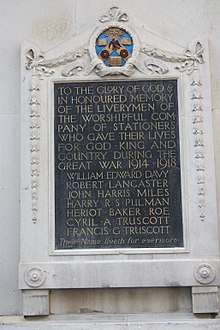
A liveryman is a full member of his respective company.
When a freeman becomes a liveryman, the candidate is said to be 'enclothed': indeed, a livery gown is placed on him at the court and he is seen at the next formal or social occasion wearing it. Thereafter only the master, wardens and assistants in companies are seen wearing these at company events. The masters wear them at the City's formal events, e.g. the two Common Halls and the United Guilds Service, and Lord Mayor's Show, wherever they may participate. Ordinarily, liverymen wear ties at formal functions and each company differs by allowing women to wear distinct items subject to the occasion, such as a scarf or brooch.
Freemen are expected to advance to become liverymen by a vote of the court of the company. Liverymen no longer have any local authority franchise in the City, but retain the exclusive right of voting in the election of the Lord Mayor of the City of London (Michaelmas 'Common Hall' 29 September) and for the sheriffs (Mid-Summer 'Common Hall' 24 June) held in Guildhall as a ceremonial occasion. The votes are made by 'acclamation' subject to a challenge/demand from the floor for a ballot which would be held a week later. Any two liverymen may nominate a candidate for the Freedom of the City.
Former parliamentary election rights
Before the Reform Act 1832 the liverymen had the exclusive right to elect the four Members of Parliament representing the City. Between 1832 and 1918 being a liveryman was one of a number of possible franchises which could qualify a parliamentary elector in the City of London constituency, as it was a preserved ancient borough franchise under the terms of the 1832 Act.
See also City of London (elections to the Parliament of England) for further details of the history of the involvement of liverymen in parliamentary elections.
Livery halls
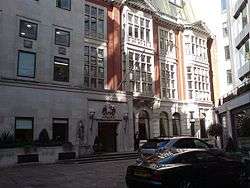
Today 39 out of 110 City livery companies own premises in London, as well as the Watermen and Lightermen which although not strictly a livery company, retains headquarters still in regular use. Among the earliest companies known to have had halls are the Merchant Taylors and Goldsmiths in the 14th century, and, uniquely, the kitchen and the crypt of Merchant Taylors' Hall survived both the Great Fire of London and the Blitz, the kitchen now having been in uninterrupted use for over 600 years.
Besides surviving parts of Merchant Taylors’ Hall, the oldest hall interiors now extant are those of the Worshipful Society of Apothecaries, dating from 1668–71; significant portions of the fabric of this building are also medieval, from the 13th-century priory part of which became the Apothecaries’ Hall. Several companies that do not have a hall of their own share office premises within the hall of another company on a semi-permanent basis, examples being the Spectacle Makers' Company, which uses part of Apothecaries' Hall, and the Worshipful Company of Shipwrights, which co-habits with the Ironmongers.[2] Many livery halls can be hired for business and social functions, and are popular for weddings, commercial and society meetings, luncheons and dinners.
Three livery companies (the Glaziers and Painters of Glass, Launderers, and Scientific Instrument Makers) share a hall in Southwark, just south of and outside the City of London, while the Worshipful Company of Gunmakers has long been based at Proof House, in the London Borough of Tower Hamlets and the Master Mariners' "hall" is an historical ship, HQS Wellington, moored on the Thames which is shared by the Scriveners' Company. Companies without halls customarily book use of another livery hall for their formal gatherings, giving members and guests the opportunity to visit and enjoy different City livery halls by rotation.[2]
Blue plaques throughout the City of London indicate where companies formerly had halls. Whilst several livery companies may aspire to owning or regaining their own hall it is appreciated that any increase in the overall number of livery halls would inevitably lead to some dilution of use of the existing halls. There is also attraction in belonging to a company which is peripatetic.[2]
Precedence
In 1515, the Court of Aldermen of the City of London settled an order of precedence for the 48 livery companies then in existence, based on those companies' contemporary economic or political power.[2] The 12 highest-ranked companies remain known as the Great Twelve City Livery Companies. Today there are 110 City livery companies, all post-1515 companies being ranked by seniority of creation.[2]
The Merchant Taylors and the Skinners have long disputed their precedence, so once a year (at Easter) they swap between sixth and seventh places. This mix-up is a favourite theory for the origin of the phrase "at sixes and sevens", as has been pointed out by at least one Master Merchant Taylor; however, it is possible that the phrase may have been coined before these two companies (Taylors and Skinners) resolved their dispute,[9] which arose from their both receiving Charters in 1327 with no proof surviving as to which was granted first.
List of companies in order of precedence
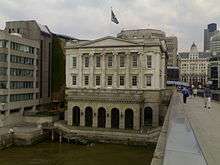
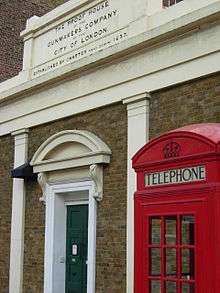
- Worshipful Company of Mercers (general merchants)
- Worshipful Company of Grocers (spice merchants)
- Worshipful Company of Drapers (wool and cloth merchants)
- Worshipful Company of Fishmongers (Fish and seafood)
- Worshipful Company of Goldsmiths (bullion dealers)
- Worshipful Company of Skinners*[10] (fur traders)
- Worshipful Company of Merchant Taylors*[10] (tailors)
- Worshipful Company of Haberdashers (clothiers in sewn and fine materials, eg. silk and velvet)
- Worshipful Company of Salters (traders of salts and chemicals)
- Worshipful Company of Ironmongers
- Worshipful Company of Vintners (wine merchants)
- Worshipful Company of Clothworkers
- Worshipful Company of Dyers
- Worshipful Company of Brewers
- Worshipful Company of Leathersellers
- Worshipful Company of Pewterers (pewter and metal manufacturers)
- Worshipful Company of Barbers (incl. surgeons and dentists)
- Worshipful Company of Cutlers (knife, sword and utensil makers)
- Worshipful Company of Bakers
- Worshipful Company of Wax Chandlers (wax candle makers)
- Worshipful Company of Tallow Chandlers (tallow candle makers)
- Worshipful Company of Armourers and Brasiers (armour makers and brass workers)
- Worshipful Company of Girdlers (belt and girdle makers)
- Worshipful Company of Butchers
- Worshipful Company of Saddlers
- Worshipful Company of Carpenters
- Worshipful Company of Cordwainers (fine leather workers and shoemakers)
- Worshipful Company of Painter-Stainers
- Worshipful Company of Curriers (leather dressers and tanners)
- Worshipful Company of Masons (stonemasons)
- Worshipful Company of Plumbers
- Worshipful Company of Innholders (tavern keepers)
- Worshipful Company of Founders (metal casters and melters)
- Worshipful Company of Poulters (poulterers)
- Worshipful Company of Cooks
- Worshipful Company of Coopers (barrel and cask makers)
- Worshipful Company of Tylers and Bricklayers (builders)
- Worshipful Company of Bowyers (long-bow makers)
- Worshipful Company of Fletchers (arrow makers)
- Worshipful Company of Blacksmiths
- Worshipful Company of Joiners and Ceilers (wood craftsmen)
- Worshipful Company of Weavers
- Worshipful Company of Woolmen
- Worshipful Company of Scriveners (court scribes and notaries public)
- Worshipful Company of Fruiterers
- Worshipful Company of Plaisterers (plasterers)
- Worshipful Company of Stationers and Newspaper Makers (journalists and publishers)
- Worshipful Company of Broderers (embroiderers)
- Worshipful Company of Upholders (upholsterers)
- Worshipful Company of Musicians
- Worshipful Company of Turners (lathe operators)
- Worshipful Company of Basketmakers
- Worshipful Company of Glaziers and Painters of Glass
- Worshipful Company of Horners (horn workers and plasticians)
- Worshipful Company of Farriers (horseshoe makers and horse veterinarians)
- Worshipful Company of Paviors (road and highway pavers)
- Worshipful Company of Loriners (equestrian bit, bridle and spur suppliers)
- Worshipful Society of Apothecaries (physicians and pharmacists)
- Worshipful Company of Shipwrights (shipbuilders and maritime professionals)
- Worshipful Company of Spectacle Makers
- Worshipful Company of Clockmakers
- Worshipful Company of Glovers
- Worshipful Company of Feltmakers (hat makers)
- Worshipful Company of Framework Knitters
- Worshipful Company of Needlemakers
- Worshipful Company of Gardeners
- Worshipful Company of Tin Plate Workers alias Wire Workers
- Worshipful Company of Wheelwrights
- Worshipful Company of Distillers
- Worshipful Company of Pattenmakers (wooden-shoe makers)
- Worshipful Company of Glass Sellers
- Worshipful Company of Coachmakers and Coach Harness Makers
- Worshipful Company of Gunmakers
- Worshipful Company of Gold and Silver Wyre Drawers (threadmakers for military and society clothing)
- Worshipful Company of Makers of Playing Cards
- Worshipful Company of Fanmakers
- Worshipful Company of Carmen (vehicle drivers)
- Honourable Company of Master Mariners
- City of London Solicitors' Company (lawyers)
- Worshipful Company of Farmers
- Honourable Company of Air Pilots
- Worshipful Company of Tobacco Pipe Makers and Tobacco Blenders
- Worshipful Company of Furniture Makers
- Worshipful Company of Scientific Instrument Makers
- Worshipful Company of Chartered Surveyors
- Worshipful Company of Chartered Accountants in England and Wales
- Worshipful Company of Chartered Secretaries and Administrators
- Worshipful Company of Builders Merchants
- Worshipful Company of Launderers
- Worshipful Company of Marketors
- Worshipful Company of Actuaries
- Worshipful Company of Insurers
- Worshipful Company of Arbitrators
- Worshipful Company of Engineers
- Worshipful Company of Fuellers
- Worshipful Company of Lightmongers (electric lighting suppliers)
- Worshipful Company of Environmental Cleaners
- Worshipful Company of Chartered Architects
- Worshipful Company of Constructors
- Worshipful Company of Information Technologists
- Worshipful Company of World Traders
- Worshipful Company of Water Conservators
- Worshipful Company of Firefighters
- Worshipful Company of Hackney Carriage Drivers (licensed taxicab drivers)
- Worshipful Company of Management Consultants
- Worshipful Company of International Bankers
- Worshipful Company of Tax Advisers
- Worshipful Company of Security Professionals
- Worshipful Company of Educators
- Worshipful Company of Arts Scholars
Note: *The Skinners' and Merchant Taylors' Companies alternate their precedence each year.
Coats of arms
| Name; Type of business | Date of establishment; Order of precedence | Image of arms | Blazon |
|---|---|---|---|
| Worshipful Company of Mercers (General merchants) | 1394 1st | 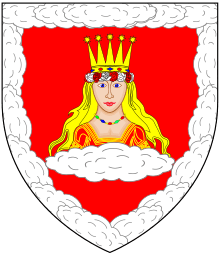 | Gules, issuant from a bank of clouds a figure of the Virgin couped at the shoulders proper vested in a crimson robe adorned with gold, the neck encircled by a jeweled necklace crined or and wreathed about the temples with a chaplet of roses alternately argent and of the first, and crowned with a celestial crown, the whole within a bordure of clouds also proper. |
| Worshipful Company of Grocers (Spice merchants) | 1345 2nd |  | Argent, a chevron gules between nine cloves six in chief and three in base proper |
| Worshipful Company of Drapers (Wool and cloth merchants) | 1361 3rd | 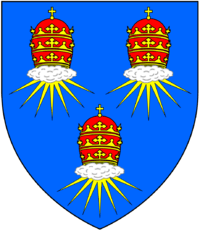 | Azure, three clouds radiated proper each adorned with a triple crown or |
| Worshipful Company of Fishmongers (Fish and seafood) | 1272 4th | 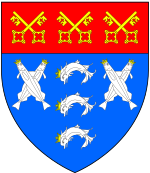 | Azure, three dolphins embowed in pale between two pairs of sea luces saltirewise proper crowned or on a chief gules six keys in three saltires ward ends upwards of the second |
| Worshipful Company of Goldsmiths (Bullion dealers) | 1327 5th | 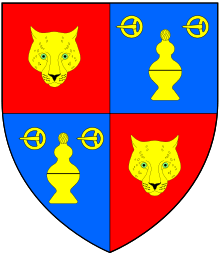 | Quarterly gules and azure, in the first and fourth quarters a leopard's face or in the second and third quarters a covered cup and in chief two round buckles the tongues fesse-wise, points to the dexter all of the third |
| Worshipful Company of Skinners (Fur traders) | 1327 6th | 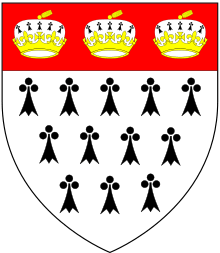 | Ermine, on a chief gules three crowns or with caps of the field |
| Worshipful Company of Merchant Taylors (Tailors) | 1347 7th | 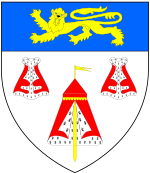 | Argent, a royal tent between two parliament robes gules lined ermine the tent garnished or with pennon and flagstaff of the last on a chief azure a lion passant guardant or |
| Worshipful Company of Haberdashers (clothiers in sewn and fine materials, eg. silk & velvet) | 1448 8th | 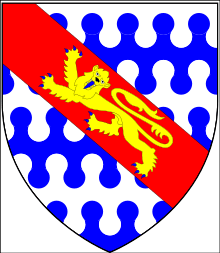 | Barry nebulée of six argent and azure, on a bend gules a lion passant guardant or |
| Worshipful Company of Salters (Traders of salts and chemicals) | 1394 9th | 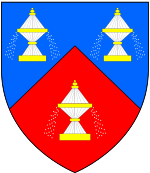 | Per chevron azure and gules, three covered salts argent garnished or overflowing of the third |
City companies without grant of livery
Companies without Livery is a status which applies during the period between when a Guild is recognised by the Court of Aldermen and when it is granted the rights of a livery. A guild initially applies to be a London Guild, and may later apply to the Court to become A Company of the City of London. After an indefinite period, such A Company of the City of London can apply to the Aldermen for livery status; if granted, they can thereafter use the honorific prefix Worshipful Company.
Guilds and companies aiming to obtain the grant of Livery
- Guild of Entrepreneurs
- Guild of Human Resource Professionals
- Guild of Nurses
- Guild of Investment Managers
- Company of Communicators
Other companies
Neither the Company of Parish Clerks nor the Company of Watermen have applied or intend to apply for livery status, which remains a long-standing City tradition. This is granted by the City Corporation in effect to control a company. The Watermen and Parish Clerks are governed by statutes and Royal Charters with responsibilities outside the City. The Company of Watermen and Lightermen was established by Act of Parliament in 1555 to regulate the watermen on the River Thames responsible for the movement of goods and passengers and remains the only ancient City Guild to be formed and governed by Act of Parliament. They are then strictly not 'Companies without Livery' at all but simply 'companies'.
The City Livery Club, The Guild of Young Freemen and the Guild of Freemen of the City of London, whilst not being livery companies, are popular clubs amongst the City fraternity.
The Southwark Manors
The City Corporation of London remains lord of three manors at Southwark (Guildable, King's and Great Liberty). These are membership organisations for those areas which are the jurors of their manorial courts. They are not in any way Guilds as are not related to trading and occupational activities. These courts retain legal-standing under the Administration of Justice Act 1977.
Gallery
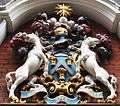 Worshipful Company of Innholders: Hinc Spes Affulget (Hence Hope Shines Forth)
Worshipful Company of Innholders: Hinc Spes Affulget (Hence Hope Shines Forth).jpg) Worshipful Company of Dyers: Da Gloriam Deo (Give Glory to God)
Worshipful Company of Dyers: Da Gloriam Deo (Give Glory to God).jpg) Worshipful Company of Skinners: To God Only Be All Glory
Worshipful Company of Skinners: To God Only Be All Glory.jpg) Worshipful Company of Cutlers: Pour Parvenir A Bonne Foy (To Succeed Through Good Faith)
Worshipful Company of Cutlers: Pour Parvenir A Bonne Foy (To Succeed Through Good Faith)
See also
References
- "Alphabetical list". City of London. Archived from the original on 18 April 2012.
- Engel, Matthew. "British institutions: livery companies". ft.com. Retrieved 22 December 2012.
- "The Worshipful Company of Bowyers". www.bowyers.com. Retrieved 21 January 2018.
- Ltd, ATG Media. "The Worshipful Company of Arts Scholars". www.artsscholars.org. Retrieved 21 January 2018.
- "Livery companies". City of London.
- "Livery Company Affiliations with the Armed Forces (Regular and Reserve)". Stepping Forward London.
- "Mary Berry leads flock of sheep over London Bridge to promote wool industry - Farming UK News". www.farminguk.com. Retrieved 21 January 2018.
- "Livery Committee". City of London. Retrieved 12 March 2015.
- "At Sixes and Sevens": Master Merchant Taylor
-
- The Skinners' and Merchant Taylors' Companies alternate their precedence each year
Further reading
- Robert Seymour (1735). "Twelve Principal Companies of the City of London". Survey of the Cities of London and Westminster. 2. London: J. Read.
- Robert Seymour Of the Other Companies Following the Twelve
- Thomas Allen; Thomas Wright (1839). "Companies of the City of London". History and Antiquities of London, Westminster, Southwark, and Parts Adjacent. London.
- Edward Mayer and Donald Adamson, The Curriers’ Company: A Modern History, 2000.
- Paul Jagger (2014). The City of London Freeman's Guide. The Worshipful Company of Information Technologists.
External links
| Wikimedia Commons has media related to Livery Companies in the City of London. |
